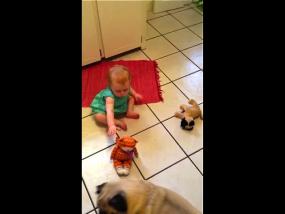An Infant's Toy: Inanimate or Animate

Zuri, one year old, has a pet dog. You will see it cross the foreground in this video. She also has two stuffed animal toys, a tiger and a dog. She makes some moves that make us believe that she expects her toy tiger to keep walking after she nudges it forward. Or is she simply making the toy move as children so often do in pretend play to simulate walking? We have a true challenge here to make our best guess about what Zuri is thinking. To decide, we will compare what she does with what she does not do, a common strategy we use at Videatives. She sits the Tiger upright and then pushes it forward while making a sort of woof-woof noise. She repeats this action three times in different locations in a radius from where she sits. She does not hold the Tiger to move it across the floor, as one would expect if she knew the toy had no autonomous movement. Instead of sliding the Tiger across the floor, it looks as though she is trying to start a movement that she wants to continue after her nudge. The nudge is more a signal to the toy to keep moving. Then there is the very interesting test of the Tiger's legs. Zuri turns the Tiger upside down and pulls its legs apart, together, apart several times. Is she testing the legs to determine if they are the reason the Tiger does not continue to move after her nudge? We have to be careful when we assume a previous action is the reason or cause for a subsequent action. But clearly she wants to know if the legs can separate, or at least to see them apart and together, apart and together. I would guess that she is trying to discover what parts of the toy move in what ways. But I would not dismiss the idea that this general interest in "what moves and how" is true for both her nudging of the Tiger forward and her separating of the Tiger's legs. How far can we go in assuming that she falsely attributes autonomous motion to her stuffed toy? Is she assuming an inanimate object is animate? I would offer a qualified "yes." She most likely would be surprised if the Tiger stood up and said, "I don't want to run just now." Most likely she would be surprised if the Tiger took off running without her nudging him first. What she has done looks very much like what children her age do when rolling balls down an incline. Instead of simply releasing the ball to let it roll on its own, they push the ball down the incline. This means the children hold the false belief that the ball does NOT have autonomous action (the pull of gravity). So what we are watching could be another example of this basic egocentricity of young children who think, in effect, "If something is to move across a space, I have to get it started." But do we have to take that next step that assumes she believes the Tiger is animate? Is it like a ball that needs a push to roll or is it like a pet that needs a signal to run? You decide. Look again at the video, enjoy, and look again. Keywords: Ones, Child-Object, Push Toy, Animate, Causation, Pretense Length of video: 54 seconds
